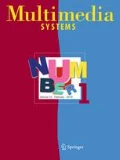Abstract
In this paper we consider the problem of allocating personal TV advertisements to viewers. The problem’s input consists of ad requests and viewers. Each ad is associated with a length, a payment, a requested number of viewers, a requested number of allocations per viewer and a target population profile. Each viewer is associated with a profile and an estimated viewing capacity which is uncertain. The goal is to maximize the revenue obtained from the allocation of ads to viewers for multiple periods while satisfying the ad constraints. First, we present the integer programming (IP) models of the problem and several heuristics for the deterministic version of the problem where the viewers’ viewing capacities are known in advance. We compare the performances of the proposed algorithms to those of the state-of-the-art IP solver. Later, we discuss the multi-period uncertain problem and, based on the best heuristic for the deterministic version, present heuristics for low and high uncertainty. Through computational experiments, we evaluate our heuristics. For the deterministic version, our best heuristic attains 98 % of the possible revenue and for the multi-period uncertain version our heuristics performances are very high, even in cases of high uncertainty, compared to the revenue obtained by the deterministic version.









Similar content being viewed by others
References
BARB: Barb reports: Monthly total viewing summary. http://www.barb.co.uk (2010)
Ben-Tal, A., Nemirovski, A.: Robust solutions of uncertain linear programs. Operat. Res. Lett. 25(1), 1–14 (1999)
Ben-Tal, A., Nemirovski, A.: Robust solutions of linear programming problems contaminated with uncertain data. Math. Programm. 88(3), 411–424 (2000)
Birge, J., Louveaux, F.: Introduction to stochastic programming. Springer, Berlin (1997)
Bollapragada, S., Garbiras, M.: Scheduling commercials on broadcast television. Operat. Res. 52(3), 337–345 (2004)
Bozios, T., Lekakos, G., Skoularidou, V., Chorianopoulos, K.: Advanced techniques for personalized advertising in a digital TV environment: the iMEDIA system. In: Proceedings of the eBusiness and eWork conference. Venice, pp. 1025–1031 (2001)
Chekuri, C., Khanna, S.: A PTAS for the multiple knapsack problem. In: Proceedings of the eleventh annual ACM-SIAM symposium on discrete algorithms, pp. 213–222. Society for Industrial and Applied Mathematics, Philadelphia (2000)
Chorianopoulos, K.: Personalized and mobile digital TV applications. Multimed. Tools Appl. 36(1), 1–10 (2008)
Dawande, M., Kalagnanam, J., Keskinocak, P., Salman, F., Ravi, R.: Approximation algorithms for the multiple knapsack problem with assignment restrictions. J. Comb. Optim. 4(2), 171–186 (2000)
Dureau, V.: Addressable advertising on digital television. In: Proceedings of the 2nd European conference on interactive television: enhancing the experience, Brighton, UK (2004)
Fleming, P.J., Pashkevich, M.A.: Optimal advertising campaign generation for multiple brands using MOGA. IEEE Trans. Syst. Man Cybernet. 37(6), 1190–1201 (2007)
Gilbert, D.: The American class structure in an age of growing inequality. Wadsworth Publishing, Belmont (2002)
Google AdWards: http://adwords.google.com (2011)
Juniper Research: Annual mobile adspend to pass $1 billion in 2008, with mobile TV to drive revenues to almost $7.6 billion by 2013. http://juniperresearch.com (2008)
Kastidou, G., Cohen, R.: An approach for delivering personalized ads in interactive TV customized to both users and advertisers. In: Proceedings of European conference on interactive television (2006)
Kim, E.M., Wildman, S.S.: A deeper look at the economics of advertiser support for television: the implications of consumption-differentiated viewers and ad addressability. J. Media Econ. 19, 55–79 (2006)
Kundakcioglu, O.E., Alizamir, S.: Generalized assignment problem. In: Floudas, C.A., Pardalos, P.M. (eds) Encyclopedia of Optimization, pp. 1153–1162. Springer, Berlin (2009)
Lekakos, G., Giaglis, G.: A lifestyle-based approach for delivering personalized advertisements in digital interactive television. J. Comput. Mediat. Commun. 9(2) (2004)
Lin, X., Janak, S., Floudas, C.: A new robust optimization approach for scheduling under uncertainty: I. bounded uncertainty. Comput. Chem. Eng. 28(6–7), 1069–1085 (2004)
López-Nores, M., Pazos-Arias, J., García-Duque, J., Blanco-Fernández, Y., Martín-Vicente, M., Fernández-Vilas, A., Ramos-Cabrer, M., Gil-Solla, A.: MiSPOT: dynamic product placement for digital TV through MPEG-4 processing and semantic reasoning. Knowl. Inform. Syst. 22(1), 101–128 (2010)
Negev consortium: http://www.negev-initiative.org (2011)
Nielsen Media Research: Advertising fact sheet. http://blog.nielsen.com (2010)
Nielsen Media Research: Snapshot of television use in the U.S. http://blog.nielsen.com (2010)
Nielsen Media Research: Three Screen Report, Q1 2010, vol. 8, http://blog.nielsen.com (2010)
NSR: Latest NSR Report Finds Mobile TV and Video Growth to be Driven by Broadcasters and Consumers. http://nsr.com (2008)
Nutov, Z., Beniaminy, I., Yuster, R.: A (1-1/e)-approximation algorithm for the generalized assignment problem. Operat. Res. Lett. 34(3), 283–288 (2006)
Oksman, V., Ollikainen, V., Noppari, E., Herrero, C., Tammela, A.: Podracing: experimenting with mobile TV content consumption and delivery methods. Multimed. Syst. 14(2), 105–114 (2008)
Park, J., Lim, B., Lee, Y.: A Lagrangian dual-based branch-and-bound algorithm for the generalized multi-assignment problem. Manag. Sci. 44, 271–282 (1998)
Paulson, L.: TV comes to the mobile phone. IEEE Comput. 39(4), 13–16 (2006)
Pramataris, K., Papakyriakopoulos, D., Lekakos, G., Mulonopoulos, N.: Personalized Interactive TV Advertising: The iMEDIA Business Model. Electron. Mark. 11, 1–9 (2001)
Shmoys, D., Tardos, É.: An approximation algorithm for the generalized assignment problem. Math. Program. 62(1), 461–474 (1993)
SintecMedia: http://sintecmedia.com (2011)
Toktas, B., Yen, J., Zabinsky, Z.: Addressing capacity uncertainty in resource-constrained assignment problems. Comput. Operat. Res. 33, 724–745 (2006)
Velusamy, S., Gopal, L., Bhatnagar, S., Varadarajan, S.: An efficient ad recommendation system for TV programs. Multimed. Syst. 14(2), 73–87 (2008)
Author information
Authors and Affiliations
Corresponding author
Rights and permissions
About this article
Cite this article
Adany, R., Kraus, S. & Ordonez, F. Allocation algorithms for personal TV advertisements. Multimedia Systems 19, 79–93 (2013). https://doi.org/10.1007/s00530-012-0284-y
Published:
Issue Date:
DOI: https://doi.org/10.1007/s00530-012-0284-y




